Porcelain Insulator News
by Jack H. Tod
Reprinted from "INSULATORS - Crown Jewels of the Wire", April 1974, page 10
Preferably direct porcelain news items and questions directly to Jack H. Tod,
3427 N. 47th Place, Phoenix, Ariz. 85018. All mail will be answered if reply
stamp is enclosed, and the most newsworthy items and questions of general
interest will be published as space permits.

Fred Richardson (Ouray, Colo.) gave the two cleats to me which are pictured
above, and after studying these for a bit I have come to the conclusion that
they are the most unusual cleats I have yet seen. Both cleats are obviously very
old, and they are crudely made from plastic clay (not dry process)! The markings
shown above are actual size.
The cleat on the left with the Star marking has side bars unlike any other
standard cleat made after about 1897. The star is recessed into a panel which
itself is recessed into the cleat surface. It has two wire grooves ribbed
helically by a bolt section soldered in the forming die.
I have an identical cleat to this except that the star is not contained in
the recessed panel, and this specimen came from the bulldozed plant site of the
Mogadore Insulator Co., Mogadore, Ohio. It appears to be a true site piece since
it is a bad firing reject. This company was organized in 1890 as Akron Smoking
Pipe Co. and started to make wiring insulators in 1896 from local stoneware
clays.
The cleat at the right above sports an "anchor" trademark as drawn
above. It has a smooth wire groove on the one end and transverse grooves on the
other end. In practice, the wire was held in the round groove of one piece and
clamped tightly with the transverse grooves on the other piece. Judging from
other patents, this is a design of the early 1890's. It is my opinion that both
cleats shown above are from the same manufacturer, although of slightly
different vintage.
Even after studying these specimens at length, it still is not clear to me
exactly how they were formed from plastic clay. It appears as though a
rectangular clay pug was used in press dies. The gray stoneware body is crudely
glazed.
Jack
BRUNT PORCELAIN COMPANY
As you know from past articles in this column, there have been numerous
companies who manufactured dry process electrical porcelain at one time or
another in their history. The backgrounds of those companies is of interest to
porcelain collectors, and it has been quite a challenge to piece together the
various puzzles. This has involved on-site research at each of the old plants
and many hours of digging in various eastern libraries.
Brunt Porcelain Co. was one of the earliest to enter the dry press insulator
business, and the abundance of specimens with the BRUNT marking makes this
company of particular interest to many collectors.
William Brunt, Sr. built a pottery in 1847 for the manufacture of Rockingham,
yellow and door knobs. This plant was located in East Liverpool, Ohio on the
west side of Market St. at 1st St. This was operated as a family company except
during 1852-53 when a partnership resulted in the name "William Brunt &
William Bloor".
In 1881, the company was operated by Henry Brunt & Son as Riverside Knob
Works, and the product was clay and porcelain door knobs. Henry was the son of
William, Sr.
In 1891, Henry Brunt & Son began manufacturing electrical porcelain
(cleats, knobs, tubes, etc.), and a separate building was soon thereafter
constructed next door on the same property to handle this business. In 1894 they
developed once-fire electrical porcelain, which process thereafter came into
general use by other companies.
In 1895 Henry Brunt retired. The door knob part of the business was taken
over by son William H. Brunt and operated as Riverside Knob Works. The
electrical porcelain part was taken over by son George F. Brunt and in
partnership with a Charles F. Thompson was operated under the name "Brunt
& Thompson".
G. F. Brunt bought out his partner's interest in 1897 and continued the
business under the name G. F. Brunt Porcelain Co. until it was purchased in 1911
by General Porcelain Co. headquartered at Parkersburg, W. Va.
(Note: General Porcelain Co. also bought the adjacent Riverside Knob Works in
1917 and operated both facilities as one, making electrical porcelain there
until abandoning the plants in the early 1920's. They were leased by G.E. Co.
and operated by T. F. Anderson for them subsequently. In 1930 the property was
bought by John C. Miller and once again made furniture-and-door knobs as
Riverside Knob Co. for several years. The plant is now defunct.)
In 1914 G. F. Brunt and others organized the Brunt Tile & Porcelain Co.
They bought a china ware pottery in North Columbus (Worthington), 0H. and
enlarged and refitted it for the manufacture of electrical porcelain and mosaic
tiling.
The insulators involved were tubes, cleats, knobs and specialty items. Both
kinds of ware were made until 1920, after which the mosaic tile line was
dropped. The plant operated until 1925 at which time the business was abandoned
and the plant sold.
The common marking used for all these years by George Brunt was simply
"BRUNT". If cleats or knobs show up with a marking "B &
T", they can be assumed to be Brunt & Thompson items of the 1690's.
After General Porcelain Co. bought the East Liverpool company, they continued
using BRUNT dies (especially specialty items) at the Parkersburg plant
thereafter. Therefore, a "BRUNT" marking on any item is not
necessarily an indication of early manufacture.
Here is something that may be of interest. A total of 8 companies, including
Brunt, were involved in a merger to form General Porcelain Co. Then in 1927 G.
P. Co. and 5 more companies merged to form Porcelain Products, Inc. This company
was bought by A. B. Chance Co. in 1956, and who sold the sole remaining dry
process plant (Carey, Ohio) in the 1960's to Clarken Co. of St. Louis, and which
operates the plant as Porcelain Products Co. at the present time.
They chase all the way back through that family tree of defunct companies in
distant areas to label their literature and advertisements "Since
1894" (based on Brunt). [They should use 1891 when Brunt started making
insulators or 1895 when the insulator operation separated out as Brunt &
Thompson.] But why go half way? They could use 1847 when Wm Brunt, Sr. erected
the original plant building!
Logically then, when you see that "Since 1885" on the brass
cornerstone down at the bank, take it with a grain of salt. That's probably when
the actual founder's great grandfather loaned his neighbor 20 bucks at 2% to
buy a cow, and that naturally taken the start of the banking business in the
family back another 50 years or so.
Dear Jack:
I used your glass insulator cleaner and it was wonderful. Then my brother has
windows with salt spray and aluminum spray coating on them, and he used your
solution. It worked wonders....
"Doc" Thomas, Travertine, Fla.
- - - - - - - - -
Dear "Doc":
Yep, we always knew it must be good for something. Use it to remove that
water scale from your sink and shower fittings, and you'll be even more of a
believer. We quit selling the stuff last year, and the whole recipe is now
spelled out in Supplement B to my book.
Jack
Dear Jack:
On Lapp insulators, I always thought the number under Lapp was a stock or
style number, but I have two different Lapp styles where the number is 6188. One
in a U-481 dated 1931, and the other is a U-634B which appears to be much newer.
Also on the U-634B there in something stamped faintly on the ear. It appears
to be K 12. Any ideas?
Ed Allandar,
Duncannon, Pa.
- - - - - - - -
Dear Ed:
Yes, except for the dates, all the 3 and 4-digit numbers on Lapp pin types
are catalog numbers, and the same number may appear on several different shapes
due to evolution of the designs over the years.
The small-groove 8 Kv (Cat. 588) started out as U-627C in 1918. Then in 1928
the catalog number became 6188 and the style changed to U-480. It changed to
U-634B in 1939 and to U-634 in 1948 (still as #6188 catalog number).
The larger groove 7.5 Kv was always a straight-side cable style (Cat. 592 and
later 6192) and similarly changed from U-462 to U-481, and then to U-512 in
1948.
As indicated by your specimens (and some of mine), they evidently weren't
too careful about branding some #6192 as- #6188 and vice versa. And there are
also many variations of both these for exact groove size, insulator shape,
details such as with-crown-dimple, etc.
The K 12 number is a factory control number, and you can just ignore it. The
Lapp "K" series was for the number of the Kiln car loader and was
perforce always an inkstamp marking of the overglaze type. All I have seen are
on the insulator crown area.

Lapp also used underglaze "G" numbers for Glaze operators and
incuse "T" numbers for Trimmer operators, but I haven't seen these on
pin types. I do have a #6188 U-634B with a neatly applied incuse M on the skirt,
and this would appear to be a trimmer operator designation.
Jack

Dear Jack:
The HESCHO marking you mentioned in Crown Jewels is found around here in
light blue and light brown, and are called Japanese insulators, but I don't
know what the letters stand for. I don't think they are "customer
markings" though. I think they are made in Japan.
Dean Axelson
Willowdale, Ontario, Canada
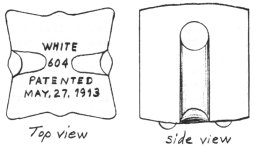
Dear Jack:
I recently found a brown strain insulator as shown at right. It has four
small firing feet on the bottom. Any information known an to company?
Vance
Rightmire
Austin, Texas
- - - - - - - -
Dear Vance:
This is a dry process, closed-end guy strain sold by T. C. White Electrical
Supply Co. This company was founded in 1914, the original location being 1122
Pine St., St. Louis, Mo. Their insulators were primarily for trolley systems.
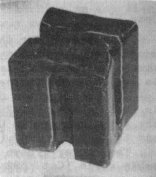
The patent referred to is Design Pat. 44,118 (7 years), May 27, 1913, Thomas
C. White. The 604 is White's catalog number for this particular size and style.
The Square-D Co. (Peru, Ind.) made these strains for White, and some
specimens have the Square-D mark in the center of the base between the firing
feet. White's round closed-end strains have three firing feet instead of four as
on this square version.
Jack
Dear Jack:
I am enclosing a sketch of a light brown trolley insulator of some sort, and
can-you tell me what this is? It has a solid metal pin cemented in.
Jerry Turner
Goshen, Ohio
- - - - - - - - -
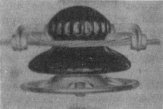
Dear Jerry:
This in an Ohio Brass Co. porcelain hanger insulator, and here is the photo
from the 1934 O-B catalog. Note the malleable iron yoke for attaching it to the
span wire. The deflector guard at the bottom was omitted when pantograph trolley
wipers were used. This Type P hanger was recommended for warm, most climates and
for tunnels and similar locations where large amounts of moisture prevail.
Jack
The photo at right top shows the rubber handstamp marking device used to make
underglaze markings. Note the 12% shrinkage of the fired porcelain over its
unfired state. The letters in this KNOX marking are of the "Hobo Type"
alphabet.
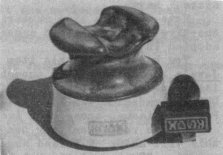

The bottom photo shows underglaze marking stamps i used by (left to right)
Illinois Electric Porcelain Co., Delta-Star, and Line Material Co. Note that the
L-M stamp has provision for removable numbers under the circle for use on
different catalog number items. None of these latter three markings were used on
pin types in this exact form.
Jack
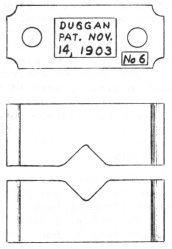
Dear Jack:
Enclosed is a sketch of a 3" DUGGAN white glazed porcelain cleat. I'm a
subscriber to Crown Jewels since Oct. of 1973 and also have Gerald Brown's
"Collectible Porcelain Insulators", but I can't find any information
on any DUGGAN items. I would appreciate knowing who made them and for whom. Also
a suggested price as a collector item.
John Beres,
Cleveland
- - - - - - - - -
Dear John:
"Duggan" was the tradename of Imperial Porcelain Works, Trenton,
N.J., founded in 1891 by, Frederick A. Duggan who had formerly been with Trenton
China Co. The plant, originally Dowds Stilt Works, had 26,000 square feet, 3
kilns, 80 workmen, and it can still be seen at 457 Mulberry St. in Trenton.
Imperial continued to manufacture standard porcelain for many years, but they
were defunct by the end of the 1930's. During World War II, parachutes were
manufactured in the large stone plant building.
The patent is #508,687 of Nov 14, 1893 (not 1903), and this covers the
interchangeable halves each with a ribbed wire notch. The date was incorrectly
1903 on dies for the #6 size but is correctly 1893 on all other Duggan cleat
sizes I have.
Note that the size numbering on these early Imperial one-wire cleats does
not agree with the porcelain standards adopted in 1897.
You hadn't seen this item because you weren't a Crown Jewels subscriber early
enough. In the Oct-Nov-Dec 1972 issues we ran a 7-page list of these markings,
and the DUGGAN tradename was identified there. Per page 48 of the Feb 1974
issue, those back issues are still available.
You're really on your own as far as price, but maybe this will help. I tossed
some #4 DUGGAN cleat pairs in my any-item-50-cents box at the Hutchinson national,
and I don't recall anyone buying any of them.
Jack
Dear Mr. Tod:
While in Colorado several years ago, I purchased a rather large porcelain
power insulator, I was wondering if you could help me to identify it, as well as
who made it, and its value.
Markings on it state BOOM or BOOR (not clear) PATENT, MARCH 8th 1898, M' F' D
BY ? ? ? (not legible). I have enclosed a picture of it to show the shape.
The man I bought it from said it came from the Cripple Creek mining district
in south central Colorado which had been in operation since the late 1880's.
While I was in Cripple Creek, I observed the power lines but did not see any in
use. I went to the dump in nearby Victor, Colo. and did find a few pieces of
this same type of insulator, but there were no whole ones to be found.
Mike
Johnson
Geneva, Ill.
- - - - - - - - -

Dear Mike:
This insulator is an early Thomas item, and the full marking is an shown
above (from my book).
The patent refers to #600,745 which is the John W. Boch, Sr. patent for the
glazefill type of construction. He was a key figure at R. Thomas & Sons in
East Liverpool, Ohio until he left in 1907 to enter the porcelain business on
his own --- and was succeeded at Thomas by his son.
There are two forms of this insulator. One is the 5" diameter U-928, and
the other the 6" diameter U-928A. The larger of these in evidently much
scarcer than the other. They were manufactured in the 1897-1900 period and
should be classed as museum pieces due to their antiquity and early design as a
power transmission insulator.
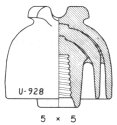
Although the U-998 is a very desirable collector item, a number have been
recovered by collectors, so we only catalog them as a $20 item. At the national
show last year, one collector had several for sale at only $5 to $10 (a bargain
for this item), but they didn't last long at that price, of course.
I think that collectors have fairly well picked over the items in dumps
around Cripple Creek, so it's no surprise that things were pretty lean when you
got there. The specimen you have appears to be in excellent condition, and you
can display it proudly as one of our early insulators. Too bad the color photo
wouldn't print.
Jack
FOREIGN PORCELAIN. We continue to receive queries about all sorts of foreign
porcelain insulators. Most of these include a sketch or photo, and the writer
uniformly asks what the marking stands for, how and where were they made, and
how much is it worth.
I have never collected foreign types, have never been outside the U.S. and
generally just don't speaka de language. Therefore, except for certain Canadian
insulators, I am completely ignorant about foreign insulators and have never
been able to answer any of the questions on them. Furthermore, I have never
known anyone who did have the answers.
I just received a letter from Gene Bond that says he is compiling information
on foreign types (he has 197 diff., from 46 countries) and that he hopes to be
able to publish something on these within a year or so. This is great news for
those interested in foreign, and everyone should take the time to assist Gene in
this even if they do not collect foreign. You can write to him directly at 15 E.
Camden Ave., Moorestown, NJ 08057. I suggest you send to him a shadow-profile
drawing and measured dimensions of each item together with the markings and
information as to their origin and use.
Jack
R. L. Perkins (Hillsboro,ILL.) reports having a U-610A Ohio Brass Co. with
Teet Rests on the crown in green. Now that's something unusual.
There are a number of pin types which were cataloged by various companies but
which I have not ever seen in any collections or trade lists. I would appreciate
knowing if anyone out there has any of the following styles: U-25, 71, 82, 105,
132, 141, 146, 166, 215, 216, 217, 252, 254, 363, 364, 370, 373, 375, 382, 394,
399D, 404, 405, 406, 408, 410A, 411, 412, 412A, 412B, 435, 520, 535, 535A, 538,
566, 593, 595, 607, 697, 697A, 703, 712, 779, 816-816A, 818A, 837, 862, 863,
865, 866, 867, and U-929.
Jack
Dear Jack:
Thought some of your readers might be interested in seeing how this insulator
was used as this one has all its hardware intact. Am mailing this insulator to
you in event you wish to make a sketch of it, and included is return postage for
it.
Dee Willett,
Bakersfield, Cal.
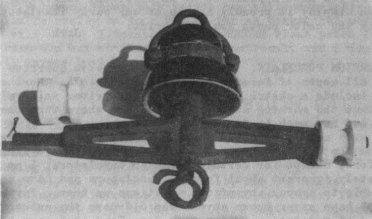
- - - - - - - - -
Dear Dee:
My sketch wouldn't do it justice, so here's a photo of it - and also showing
the incuse Lapp marking on the U-361 pin type. Note the notched marker giving a
date code of 1920, 3rd quarter. I've also included in the photo the two
porcelain knobs and cotter keys which are needed to make it really complete.
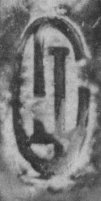
These are lamp hangers for series-connected street lights, and see page 25 of
the Oct. 1972 Crown Jewels. The top loop attaches to the mastarm, and the
luminary attaches to the bottom hook The porcelain knobs give support to the
leadin wires from the mastarm to the luminary inlet bushings.
True, most of these top-clamp arrangements were made for the mushroom-shaped
pin types (or vice versa), but these and similar pin types were cataloged as
just another pin type shape and were extensively used as ordinary pin type
insulators on crossarms.
There are many forms of these lamp hangers dating from the 1890's to fairly
recent years, and all of them I have seen are very interesting gismos from the
mechanical standpoint. For someone looking for something different, these would
make a really nice collection.
Jack
| 